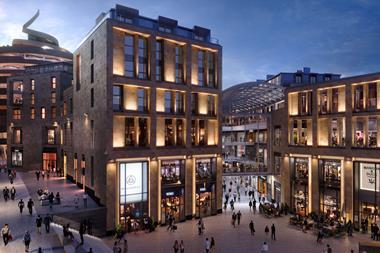While shopping centre sustainability initiatives can be constrained by negotiations, a wave of legislation could force home the potential savings

To see the sustainable shopping centre of the future, you don’t need to go far. In fact a trip to your local mall will do. Because for all the focus on making new buildings greener, the majority of centres that will be in existence 20 years from now are already built, open and trading.
Most of those were developed without sustainability on the agenda and those inherent issues - both physical and political in terms of landlord and retailer arrangements - need to
be resolved if more energy efficient, sustainable shopping environments are to evolve.
Not that the retail industry has much choice, encircled as it is by impending legislation from Whitehall and Brussels, most of which has the backing of the real estate sector in principle, if not always in detail.
This month the Carbon Reduction Commitment Energy Efficiency Scheme (CRC) came into force in an initiative led by the Environment Agency.
In essence a CO2 emissions trading programme, it is mandatory for the 5,000 organisations that used more than 6,000 megawatt hours of electricity in 2008. For the first year businesses must report their emissions and after this, carbon allowances will be sold at a fixed price, initially at £12 per tonne.
In 2011, all participating organisations will have their progress ranked in a public league table.
The issue, essentially, boils down to energy management. Simple as that sounds, in a shopping centre things are rarely easy. “There are some relatively straightforward things we can do as a shopping centre operator but malls are complex, which is where the challenge to progress lies,” says Land Securities environmental director Dave Farebrother.
He points out that as a landlord the company is actually responsible for only a small part of the centre’s overall energy load. Land Securities does not have air conditioning in its centres, lamps can be replaced by energy efficient versions and energy management systems can be installed; but these pale into relative insignificance compared with the loads generated by the retailers.
Farebrother believes that even upgrading common area services can be controversial for retail tenants. “In a typical case we would be looking at payback within two years in lower energy costs - not bad in anyone’s book,” he says. “As a business we would want to recharge the capital outlay but it seems that often a retailer’s pot for rents and their pot for service charges are completely separate, so the buy-in is not necessarily there.”
Paul Sutcliffe, sustainability manager at agent DTZ, concurs but notes a gradual shift in attitudes and increasing examples of effective initiatives. However, he says that the sector as a whole lacks focus.”It is a question of priorities,” he reflects. “Store managers are still primarily incentivised on sales not on energy savings, even though they help the bottom line. The head office needs to specify this as part of its performance assessment.”
Farebrother foresees that a business like Land Securities - which under the terms of the CRC is the responsible party - could be looking at a bill of about £1m initially but points out that as trading allowances become more punitive that could rise to more like £6m. “We need a mechanism that incentivises the retailers within the scheme,” he reflects.”
Get the little things right
Debbie Hobbs, principal at consultancy Environ, says housekeeping and data management are the first actions landlords and retailers need to take. “Check the timings on equipment, the temperatures and settings,” she says. “Then manage your data. A lot of companies don’t even realise that they can’t use estimated readings for example, or that most air conditioning systems need an inspection certificate.”
Some retailers have adopted advanced metering and Hobbs believes that most good landlords are doing what they can but says the impasse between capital expenditure, albeit with a clearly defined payback period, and service charges is blocking as much as 30% of potential energy savings.
“CRCs might help because they will get landlords and retailers talking and perhaps down the line even longer term payback models might be accepted by retailers,” she argues.
Philippa Latimer, public affairs manager at the British Council of Shopping Centres, says the weight of legislation heading towards the retail sector should also force landlords and retailers to align. “Aside from CRC you have the proposed replacements for Energy Performance Certificates, the EU’s Energy Performance of Buildings Directive and the UK’s zero carbon pledge for new buildings by 2019,” she says. “All this legislation will pass into law and it will drive people to work together.”
The increasing cost of energy and incentives to feed green energy back into the grid may also spur action, adds Richard Buckingham, head of sustainability at architect BDP. “The government incentive has probably halved the 25-year payback for putting solar panels on a shopping centre roof,” he says. “If energy prices keep going up, that payback will get shorter.” He points to out-of-town sites for wind power generation and opportunities with new mixed-use schemes to look at heat exchange between the retail and residential elements.
And Buckingham also suggests that retailers may need to rethink their store approach. “There is an undoubted issue with lighting and the question of whether retailers use too much,” he says, adding that the mall manager may eventually make retailers reappraise. “Perhaps we will get to the stage where the landlord simply says to each store: ‘This is how much power you’ve got available, now you choose how you allocate it’,” he says.
In the meantime, practical solutions are the name of the game. Land Securities sets each of its shopping centre managers the task of coming up with an energy-saving scheme each year, and contributes funding equivalent to the money it would save in offsets.
A range of ideas have been carried forward, including one of the most effective and straightforward, where back-of-house corridor lights were switched over to presence detectors and went from 24-hour use a day to about one hour. Simple.
Green thinking
Whatever happened to…
Green leases?
Green leases were briefly touted as the answer to aligning interests. Property owner’s group The Better Buildings Partnership published a toolkit for green leases last year in an attempt to “fill the gap” for existing lease structures. Organisations including Asda, Costa Coffee, WHSmith, Marks & Spencer and B&Q have already signed green leases.
“At around the time this was being discussed, the recession hit. But it is an issue that needs to be addressed, especially for existing leases,” says DTZ sustainability manager Paul Sutcliffe.
WSP Environmental & Energy director Chris Stubbs adds: “Some landlords are signing non-binding memorandums of understanding with retailers, which effectively say: ‘If we do our bit we expect you to do yours’. It starts a dialogue and I believe green rents will come.”
Sustainable premiums?
Once upon a time a school of thought went that by making shopping centres more sustainable developers would be able to attract an investment premium at the outset or on re-sale.
“The property industry is valuer-led and valuers are not yet convinced,” says British Council of Shopping Centres (BCSC) president Martyn Chase. “I think it is just too early to have the evidence, although I believe it will come. Where I think we may see more movement is when analysis shows that more sustainable centres have a longer usable life. If sustainable design adds another 10 or even 20 years to a centre, that has an enormous income potential.”
Energy efficiency through Energy Performance Certificates?
As Energy Performance Certificates descend into a tick box exercise, enter Display Energy Certificates (DECs). Currently not mandatory, DECs measure the operational efficiency of a building and BCSC public affairs manager Philippa Latimer says that not only are they more accurate but that if results were widely publicised they would provide another driver towards energy efficiency. “We would also like to see ratings changed so they are more easily understandable for shoppers - for example, very good would be A grade not C grade,” she says. “DECs are at consultation at the moment but will require primary legislation so we are not likely to see it pass into law until late 2011.”
The sustainability drive
- 1
- 2
- 3
- 4
- 5
- 6
 Currently reading
Currently readingShopping centre sustainablity: A force for good































1 Reader's comment